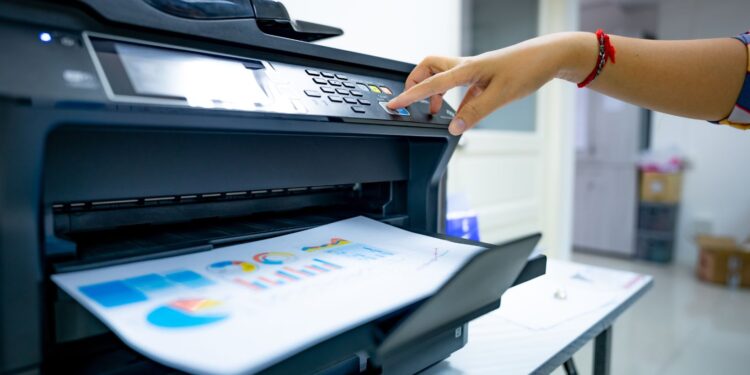Do you want to save time juggling multiple printers and dealing with constant paper jams? The inefficiency of outdated printing solutions can significantly hinder your productivity. However, modern printing technology offers a solution to these challenges.
That said, this article will explore how advanced printing solutions can revolutionize your office workflows and boost overall efficiency.
Multifunction Capabilities
The rise of multifunction printers (MFPs) has revolutionized the office environment by consolidating various functions—such as printing, scanning, copying, and faxing—into a single machine. One of the most popular options in modern offices is the office laser printer, known for its speed, precision, and cost-efficiency.
These devices reduce the need for multiple standalone machines, saving both space and energy. MFPs streamline office operations by allowing employees to perform various tasks from one device, improving convenience and reducing clutter.
Cloud-Connected Printing
Modern printing solutions have embraced cloud technology. They allow employees to print documents directly from the cloud, eliminating the need for physical storage devices or direct connections to printers. With cloud-connected printing, employees can access printers from remote locations, making it ideal for hybrid or fully remote workplaces.
Workers can send documents to print while on the go and pick them up later from any office location. This seamless integration between the cloud and printers improves flexibility, as files can be securely stored in the cloud and accessed across different devices. Additionally, cloud printing reduces the need for local IT management, as updates, configurations, and troubleshooting can often be handled through cloud services.
Mobile Printing Solutions
The shift toward mobile devices in the workplace means that employees are increasingly relying on smartphones and tablets for work-related tasks. Modern printers address this need by providing mobile printing solutions that enable users to print directly from their mobile devices. This eliminates the need to transfer files to a desktop or laptop before printing, saving valuable time.

Mobile printing apps and direct wireless connections make it easier for employees to print wherever they are, supporting more efficient workflows. Whether in meetings, during travel, or even working from home, employees can send documents to print via mobile apps.
Document Management Integration
Printers are no longer isolated machines but are integral parts of comprehensive document management systems (DMS). These advanced systems allow users to scan and digitize paper documents, which can then be automatically categorized and filed into designated digital folders. This eliminates the manual process of naming and storing files, reducing the risk of misfiling or losing important documents.
Many modern printers feature Optical Character Recognition (OCR) technology, which converts scanned documents into searchable, editable files. This makes it easier to retrieve specific documents, search for key terms, or edit existing content, streamlining document handling and improving overall office efficiency.
Advanced Scanning and Automation
Scanning is no longer just about creating a digital copy of a physical document. Modern multifunction printers (MFPs) come equipped with advanced scanning technologies that transform how businesses handle documents.
OCR is one such feature that allows scanned documents to be converted into editable and searchable files. This not only improves document accessibility but also enables automated processes, such as sorting documents into the correct folders or automatically sending scanned items to specific email addresses or cloud storage locations.
Security Features
As offices handle an increasing amount of sensitive information, document security has become a top priority. Modern printers now come with sophisticated security features designed to protect sensitive data. Secure print release ensures that sensitive documents are printed when the authorized user physically arrives at the printer and authenticates their identity, typically through a PIN, card swipe, or biometric system.
Additionally, printers now offer encryption for stored and transmitted data, preventing unauthorized access. These devices often provide audit trails, tracking who accessed specific documents, when, and from where, which is essential for industries with strict compliance regulations, such as healthcare, finance, and legal sectors.
Cost Control and Monitoring
Managing the costs associated with office printing has always been a challenge, but modern printers provide detailed monitoring and reporting tools that allow businesses to track better and control their printing expenses.

Advanced software can monitor print usage by department or individual users, offering insights into printing behaviors that may be costing the company unnecessarily. For example, it can identify excessive color printing or single-sided prints and provide opportunities to set company-wide rules, such as mandatory double-sided printing.
Sustainability and Eco-Friendly Printing
With sustainability becoming an increasingly important consideration for businesses, modern printing solutions are designed to minimize environmental impact. These printers often come equipped with eco-friendly modes that reduce energy consumption, such as sleep modes or automatic shut-off after a period of inactivity.
Ink and toner-saving technologies help reduce the number of resources used per page, and many devices support printing on recycled or certified sustainable paper. In addition, many modern printers use cartridges that are easier to recycle, and some manufacturers even offer take-back programs to ensure that used cartridges are properly disposed of.
Conclusion
The adoption of modern printing solutions is a strategic move for any organization seeking to enhance efficiency and competitiveness. By investing in advanced technologies, businesses can streamline workflows, reduce costs, and improve overall productivity.














































































































